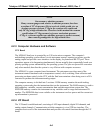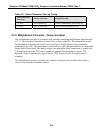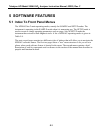
Teledyne API Model 200AU NO
X
Analyzer Instruction Manual, 02293, Rev. F
4-7
4.2.6 Power Supply Module
The Power supply module supplies AC and DC power to the rest of the instrument. It consists of
a 4 output linear DC power supply and a 15 volt switching supply. In addition, it contains the
switching circuitry to drive the DC operated valves and several switched AC loads to operate the
Rx cell heater, the Moly heater, and the ozone generator.
4.2.7 Pump, Valves, Pneumatic System
A standard M200AU comes with 2 valves. The NO/NO
x
valve switches sample from either the
sample inlet port or from the moly converter into the reaction cell. Each NO/NO
x
cycle, the Pre-
reactor valve re-routes sample gas into the Pre-reactor volume which allows time for the NO-
Ozone reaction to complete. The pneumatic timing of the Pre-reactor is set so that any
hydrocarbon interferences are measured and eliminated from the signal.
The M200AU is equipped with a high performance pump, capable of producing a reaction cell
pressure of less than 4” Hg-A. See Figure 2-3 for hook-up information. A catalytic ozone
scrubber protects the pump from the corrosive effects of ozone. See Section 4.2.8.
4.2.8 Ozone Generator
Because of the instability of ozone, it is necessary to generate this gas inside the analyzer. The
ozone generation module consists of a high frequency switching AC supply and pulse
transformer connected to a silent discharge tube. Air is supplied to the generator from a
permeation type air drier. A complete description of its function and service requirements can be
found in Section 9.3.6.
Although there are dangerous high voltages generated in the ozone generator, they are isolated
from the user by sealing the system in a single potted assembly. The dry air supply for the ozone
generator uses a membrane drier to supply air with a dew point of 0
o
C or less. The exhaust side
of the membrane is connected to the vacuum manifold at the rear of the instrument.
Normal room air contains enough water vapor to damage the generator and components
downstream. Because of this, the ozone generator may not turn on immediately at power up.
A heated catalytic ozone scrubber, located in the molybdenum converter assembly removes
excess ozone from the instrument exhaust. The delay is built into the instrument to allow the
dryer to start operating and purge the system with dry air. Table 4-2 details the conditions for
turning on the ozone generator.


















